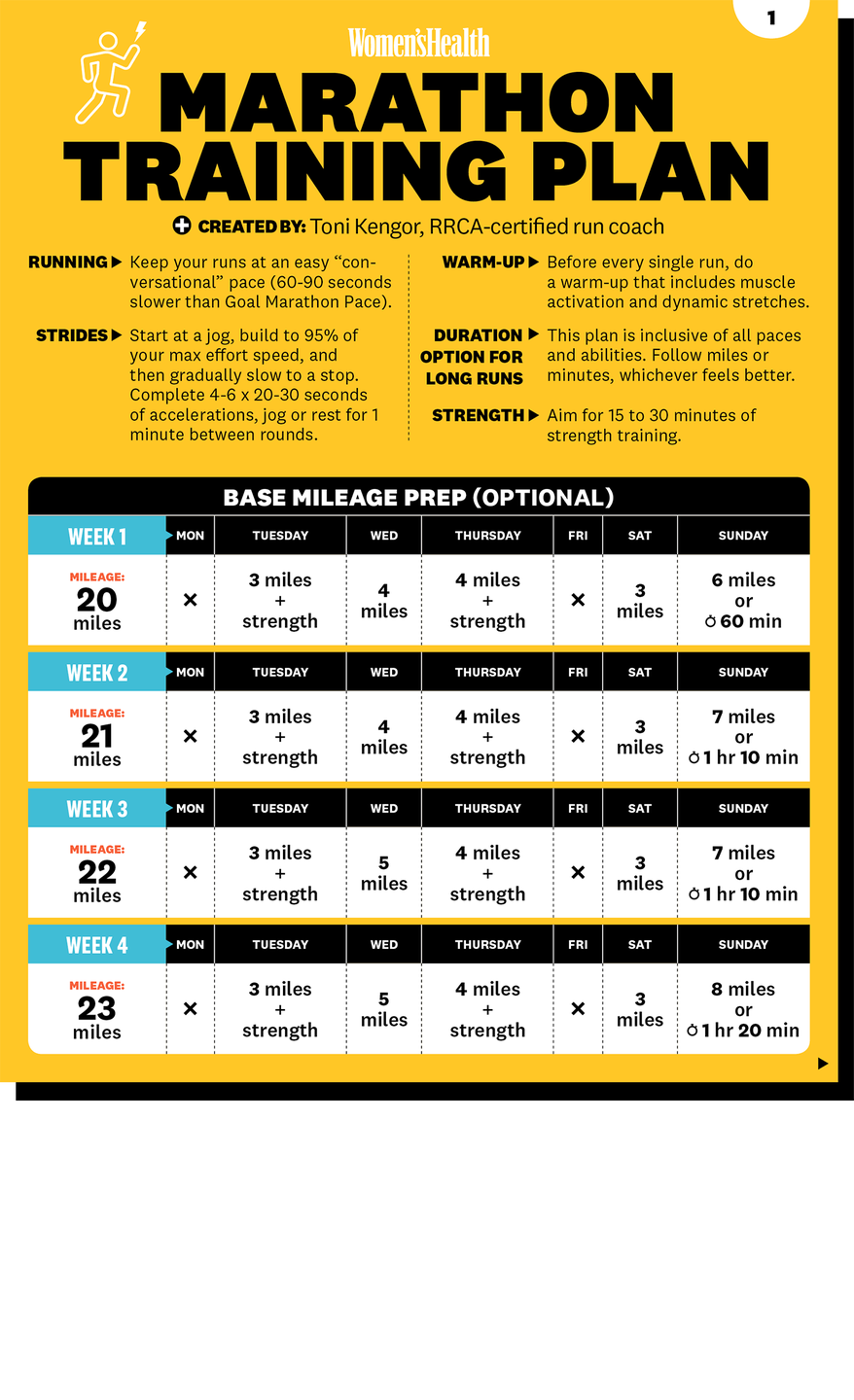This Marathon Training Plan Will Help You Go From Couch To 26.2

"Hearst Magazines and Yahoo may earn commission or revenue on some items through the links below."
Running a marathon can be a daunting feat. Yet, each year, millions of people participate in marathon races worldwide. Perhaps you have your sights set on one of the majors (Boston, New York City, London, Berlin, or Chicago) or a local course. Getting to the start healthy, let alone crossing the finish line after 26.2, takes some hard work and planning.
You’re going to need a solid training plan to rock race day. (Especially if you want to come out of it injury-free!)
WH worked with running coach Toni Kengor to put together an 18-week marathon training guide packed with tricks and tips for runners of *all* levels. Yep, if you’re tackling a couch-to-marathon situation or you’re a regular runner, you’ll be able to work with this flexible, easy-to-use guide.
Meet the experts: Toni Kengor is a RRCA-certified running coach and the founder of Relentless Runners Training Club. Annick Lamar is a USATF- and RRCA-certified running coach with New York Road Runners.
And remember: If you’re intimidated by marathon training, don’t stress. Sure, there are many miles ahead, but you’ll also mix in different forms of cardio cross-training, strength sessions, and of course, rest days to keep things interesting. You’ve got this. Let’s get started, shall we?

How To Use The Marathon Training Plan
Before you hit the road on your first run, make sure you understand all the components of marathon training. It's not just running and every sweat sesh and rest day is there for a reason. Here's how Kengor breaks it down:
First, you want to build your base. That means you’re regularly running around 18 to 20 miles per week at least three to four weeks before you start marathon training. This is what Kengor calls the “base weeks” of the plan, which will help you prevent injury if you’re in a couch-to-marathon situation. If you’re already running often, you can skip the base weeks.
Plan to run five days per week. Your training plan is organized by week from a Monday to Sunday perspective. Rest days (official permission to relax) are scheduled on Mondays and Fridays. Your weekly mileage on your five running days will rise and lower each week to help you gently get up to around marathon distance.
Spend five minutes doing warm-ups. Kengor recommends a minimum of five minutes of dynamic stretches and muscle activation exercises before each run. Her go-to dynamic stretches are leg swings side to side and leg swings front to back. For muscle activation, loop a mini band around your thighs and complete 10 each of side steps, zig-zag steps, monster walks, clamshells, and bridges.
Finish strong with strides. On Tuesdays and Saturdays, you’ll be tackling what Kengor (and many in the running community) call strides to the end of your runs. Aim for five sets of 20- to 30-second accelerations, starting at a jog and building up to ~95 percent of your max speed. It’ll help you build up to faster, more controlled efforts.
Strength training is as important running. This plan has strength training twice per week, mainly on Tuesdays and Thursdays. Aim for 15 to 30 minutes of strength training per designated day, Kengor says. Exactly what you do is up to you. This can be upper body, glutes, lower body, or core-focused strength work using bodyweight or resistance bands, Kengor says.
Reframe how you think about long runs. What makes this plan the best for beginners and experienced runners is you can determine the length of your long runs by minutes or miles. Pick whichever is easier for you to tackle mentally and physically, Kengor says. Think of it like this: you could go for a long run with the intention to go for seven miles, or for an hour and 10 minutes. Plus, running for hours and hours to hit a mileage target isn't beneficial. Kengor curbs long runs at 3 hours, so you can recover and be ready for the next week of workouts and race day.
There’s room for flexibility. The workouts are organized intentionally, but don’t worry if you need to switch things up, either. For example, if you have your kiddo’s soccer games every Tuesday night, feel free to take your rest day then and do your run on a different day instead. Try to avoid strength days back-to-back, and running five days in a row.
Yes, this is a lot to throw at you—so take a deep breath and take it in! If it helps, you can even print out this plan and post it somewhere in your home to look at and check off regularly. You can also keep a training log, Kengor says, so that you can write down how each of your runs went, your time and distance, how you felt, etc., to track your progress as you go.
How To Determine Your Pace
Think about it: You won’t be able to maintain a full-out sprint for 10 miles straight. Your runs need to be comfortable so that you can continue going for longer distances.
Not sure how to determine your ideal pace, exactly? Consider the following: “Aerobic fitness is optimized when you do something called conversational pace,” explains run coach Annick Lamar. “It is the pace in which your body has optimized how it's working to build your aerobic system,” Lamar says, and running a marathon is all about building up that aerobic development.
Gauge your “conversational pace” by running with another person and trying to chat as you go. If you find that you’re breathy and can’t speak in complete sentences, try slowing it down. “The challenge of the marathon isn’t in the first miles, but the later miles,” Lamar says. So, the conversational pace helps make sure you have enough energy to put one foot in front of the other throughout the entire course on race day.
How To Avoid Injury Training For A Marathon
Here's where warm-up exercises come in, per Kengor. Before every workout spend at least five minutes doing dynamic stretches (hip rotations, lateral lunges, leg swings front to back, and leg swings side to side) and muscle activation exercises to get your blood flowing and muscles ready for running.
Download the full marathon training plan here
Wonder what happens if you miss a run or a week of training? It’s ideal that you don’t miss any weeks of training throughout the program, but sometimes life happens. If you *do* have to miss a week, or you can’t complete a full week, Kengor recommends *repeating that week* and then moving on to where you should be in the sequence once you’ve completed it.
Why repeat? “You don't want to continue jumping to the next thing if your body hasn't had time to adapt to what was planned,” Kengor says. Basically, there’s a natural progression in the program that you want to mimic as much as possible to avoid hurting yourself, k?
Strength training also helps prevent injuries. “It can be as simple as 15 minutes,” Lamar says, primarily with bodyweight exercises targeting the core muscles related to running (planks, pushups, squats, single-leg squats, step-ups, calf-raises, and more). All of these will help your posture while you run, so you stay strong and maintain good form even when fatigued, Lamar says.
Need an injury-prevention sesh? Check out this 20-minute workout:
And of course, post-run or workout of any kind, it’ll be important for you to stretch and roll out to keep those legs loose and fresh for your next run.
Best Marathon Training Books
If you're looking for a place to gather more info about the in's and out's of running marathons or running in general, grab one of the expert-suggested reads.
Best Marathon Training Gear
Consider stocking up on some cushioned running shoes, running hats, high-impact sports bras, running shorts, and additional accessories recommended by experts. Yep, the right equipment can help you level up your performance.
Frequently Asked Questions
Now that you have all the information you need to run your fastest (or first!) marathon, you may still have some questions. These are the marathon runner FAQs and answers from experts:
How many months do you need to train for a marathon? And how long does it take to train from couch-to-marathon, specifically?
Marathon training can range anywhere from 12 to 20 weeks, depending on how often you run already and how experienced you are with the marathon distance, Lamar says. This program is 18 weeks long, and it is meant to be used by beginner runners and regular runners alike.
If you’re running from couch-to-marathon, you want to prepare earlier by adding three to four “base weeks.” Spending 21 to 22 weeks training with Kengor's program ensures you gradually build up your distance and avoid injury.
How do I create a marathon training plan?
It's all prepped for you (download it here) by a certified running coach. “I encourage runners to have a plan that is built by a coach and has flexibility to it,” Lamar says. This PDF plan hits the mark—you can add on “base weeks” if you need extra time to build up your mileage, you can switch days around if need be, you can adjust your long runs to go by time or distance, your strength workouts are up to you, and more.
Want a custom marathon training plan instead? You can also work with a personal running coach that can adapt a plan for you as you go (like Relentless Runners Coaching!), or you can even download an app (like the NYRR Coaching Lab by Runcoach!) that allows you to input mileage as you go and adjusts based on your performance.
How long do marathon runners train each day?
It varies widely. TBH, the length of time marathon runners train each day just depends on the distance of their run and if they’re tacking on extras like strength training, strides, or stretching as they go. “Training could be anywhere from 30 minutes on their easier days to up to two and a half hours on a long run,” Lamar says. And, don't forget those rest days!
All of your runs should increase in duration and intensity the closer you get to race day. Then, you'll taper to lower mileage in the couple weeks leading right up to the marathon to make sure you’re as fresh-legged as possible, Lamar explains.
You Might Also Like

